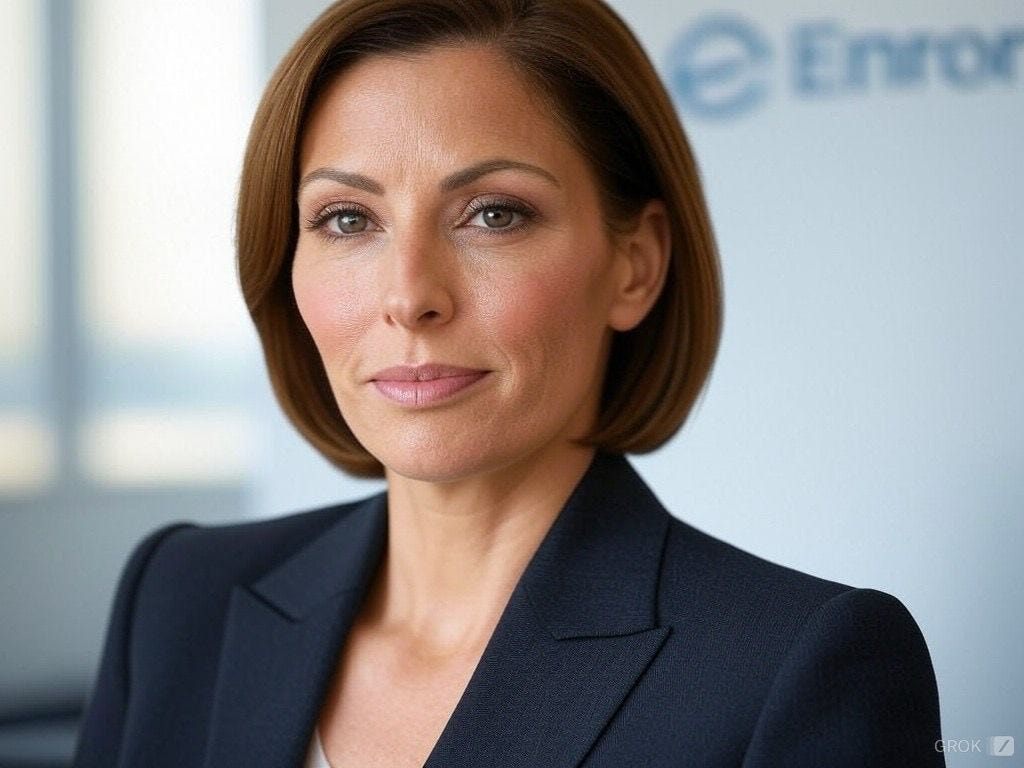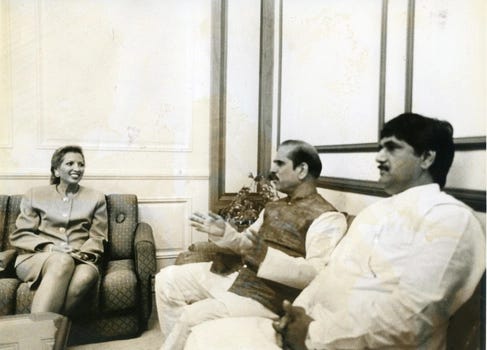Enron is back! Rises from the Ashes
Whether it soars like a phoenix or crashes (again) in spectacular flames, one thing is certain: we’re all watching. Premiers on January 6.
Enron Rises from the Ashes: A Controversial Comeback
Enron is back! The same Enron that burned hotter than the sun and fell just as spectacularly in 2001, marking one of the most infamous corporate implosions in history. The energy titan’s reemergence has rekindled memories not just of financial scandal but of its seductive former CEO, Rebecca Mark—a figure as polarizing as she was magnetic. Known for her sharp business acumen and an undeniable allure often described as “feminine energy” or even an "oomph factor," Mark was rumored to have cracked high-stakes deals worldwide, including in Maharashtra, India. Whispers of bribery involving top Indian politicians, though never proven, added a layer of controversy to her already storied tenure.
Now, in a twist no one saw coming, Enron is being resurrected by Harvard-educated provocateur Connor Gaydos, a 28-year-old satirist best known for his viral "Birds Aren’t Real" conspiracy movement. With a legacy as scandalous as it is fascinating, Enron’s return under Gaydos’s cheeky leadership has sparked disbelief, curiosity, and, dare we say, a tinge of excitement.
The Phoenix Rises (And Smirks)
The world stood still on December 2, 2024, when billboards in Houston coyly proclaimed, "We're back. Can we talk?" It was a flirtatious reintroduction—one dripping with irony for those who remember the ashes Enron left behind. Soon, a full-page ad in the Houston Chronicle followed, along with a flashy promotional video showcasing a sleeker, modernized Enron logo. For better or worse, the beast had been reborn.
Behind this resurrection is Connor Gaydos, a self-styled corporate provocateur best known for the "Birds Aren’t Real" satirical movement. Acquiring the Enron name for a laughably low $275 in 2020, Gaydos’s brand of mockery, paired with genuine business savvy, has made him the kind of man you can’t ignore. Whether this relaunch is the corporate world’s most audacious joke or a real attempt to shake up energy markets remains an open—and tantalizing—question (video).

A Brief Seduction: Enron’s Past
Let’s not forget how we got here. In its original incarnation, Enron was the corporate darling of the 1990s—a seductive powerhouse of innovation and audacity. But behind the charm was a rotting core. Using labyrinthine accounting schemes to disguise billions in debt, Enron projected an image of unmatched profitability. The illusion shattered in 2001 when the house of cards collapsed.
The fallout was cataclysmic. Thousands of employees were left jobless and penniless, top executives were slapped with criminal charges, and Arthur Andersen, one of the world’s largest accounting firms, its statutory auditor, dissolved into oblivion. Among the indicted was Rebecca Mark, one of Enron's most prominent and glamorous executives, who played a pivotal role in expanding the company’s global footprint. Though she wasn’t directly implicated in the scandal, her controversial role in Enron's disastrous investment in water markets and her aggressive, high-profile leadership contributed to the company’s culture of risk-taking. After resigning in 2000, Mark largely vanished from the public eye, avoiding the prison sentences that befell other executives like CEO Jeffrey Skilling and CFO Andrew Fastow. The latter served six years in prison, while Skilling, once the face of Enron’s arrogance, served 12 years.
Mark’s quiet exit was a stark contrast to the drama that engulfed her male counterparts. While they were tried and sentenced, she faded into obscurity, her name rarely mentioned in discussions about Enron’s downfall. Yet her legacy as a key architect of its rise—and her association with its reckless ambition—remains part of the company’s lore.
The Dabhol Saga: Enron’s India Seduction
Enron's global ambitions extended beyond U.S. borders, with one of its most ambitious—and contentious—ventures taking root in India. The Dabhol Power Project, initiated in the early 1990s, became a lightning rod for controversy, weaving a tale of political intrigue, economic miscalculations, and cultural friction.
The project began in 1992 under Maharashtra’s Congress-led government, championed by then-Chief Minister Sharad Pawar, and quickly secured a power purchase agreement with the Maharashtra State Electricity Board (MSEB). This marked the beginning of what was envisioned as a game-changing energy partnership. But the winds of political change turned against Enron when a new Shiv Sena-BJP coalition government came to power in 1995, promptly cancelling the agreement in a fiery display of nationalist fervor. However, economic pragmatism soon prevailed, and negotiations resumed, leading to a revised agreement by early 1996.
Despite these political skirmishes, the Dabhol plant’s first phase became operational by 1999, delivering 695 megawatts of power. But the arrangement proved economically unsustainable, as MSEB struggled to meet the exorbitant costs of electricity, resulting in mounting debts. By 2001, MSEB owed $45 million to the Dabhol Power Company. This financial strain, compounded by public and political opposition, culminated in the Maharashtra government’s decision to terminate the agreement. Shortly thereafter, operations at Dabhol ceased, leaving behind a behemoth of unfinished infrastructure.
When Enron filed for bankruptcy in late 2001, Dabhol’s fate became even murkier. Legal disputes over the assets ensued, with Enron attempting to recoup losses through claims against U.S. investment agencies. Ultimately, the once-grand project was salvaged by Indian entities, with its assets transferred to Ratnagiri Gas and Power Private Limited (RGPPL). Today, the Dabhol Power Station stands as a relic of Enron’s ambition, symbolizing both the opportunities and pitfalls of foreign investment in India’s energy sector—a sobering footnote in the company’s turbulent history.
Satire or Serious Business?
Coming to comeback, the answer isn’t clear, and that’s precisely the point. Gaydos thrives in ambiguity. On one hand, the “new” Enron talks about “scalable, sustainable solutions” and solving the energy crisis. On the other, its website features a disclaimer that it’s “First Amendment-protected parody.” And then there’s Gaydos himself, whose very existence seems designed to blur the lines between jest and genius.
Yet whispers of something more serious lurk beneath the theatrics. Rumors abound about a cryptocurrency initiative or even a breakthrough energy technology to be unveiled at the so-called “Enron Power Summit” on January 6, 2025. If true, this may be more than just an elaborate performance art piece.
A Pie in the Face (Literally)
As if the circus wasn’t lively enough, Gaydos recently found himself the star of a viral video for reasons as absurd as they are symbolic. Entering a building in New York, the young CEO took a cream pie to the face—an unmistakable callback to the infamous Bill Gates incident decades earlier. Social media exploded, with memes likening Gaydos to a modern-day corporate jester.
But if the pie was meant to humiliate, Gaydos didn’t flinch. His response? A cheeky tweet: “Well, at least it wasn’t Enron’s accounting team throwing that thing.” The man clearly knows how to play to an audience.
The World Awaits: Farce or Fortune?
So here we are, perched on the edge of the unknown, waiting for January 6. Will the "Enron Power Summit" deliver groundbreaking innovation, or will it reveal this entire escapade as a glorified punchline? Maybe that’s the brilliance of Connor Gaydos’s game—he’s making us pay attention to a name we thought was buried in the annals of corporate infamy.
The tension is palpable. Is this a genuine attempt to rewrite history, a commentary on the absurdity of corporate culture, or both? Speculation has even turned to India, where Enron’s infamous Dabhol Power Project left behind unfinished infrastructure and haunting memories of alleged bribery and ambition gone awry. Could relics of Enron’s past rise from the ashes on Indian soil? Or might new power players—Adani, Ambani (Anil), et al—step into the fold, not necessarily in league but perhaps as opportunistic collaborators? Such a partnership, if it were to emerge, could redefine the energy sector and give this narrative an unexpected global twist as well as spicy tales.
As one bewildered observer put it, “It’s like watching a soap opera where the villain comes back from the dead—completely implausible, but you can’t stop watching.”
And that, perhaps, is the magic of the New Enron. In a world saturated with cynicism, it has managed to grab our collective imagination, even if just for a moment. Whether it soars like a phoenix or crashes (again) in spectacular flames, one thing is certain: we’re all watching.
And isn’t that what Enron has always been about—commanding attention, for better or worse?





